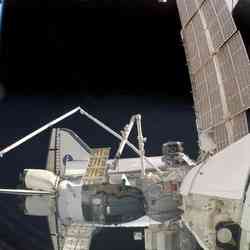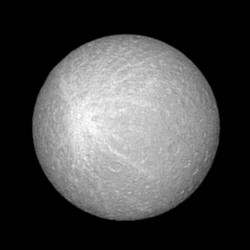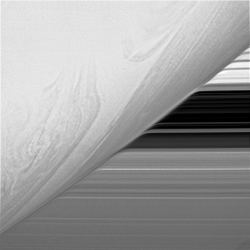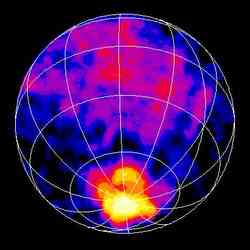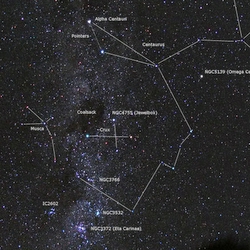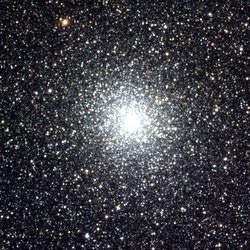
Globular cluster M22. Image credit: N.A. Sharp/REU Program NOAO/AURA/NSF. Click to enlarge.
Monday, August 1 – Today is the birthdate of Maria Mitchell. Born in 1818, Mitchell, became the first woman to be elected as an astronomer to the American Academy of Arts and Sciences. She later rocketed to worldwide fame when she discovered a bright comet in 1847.
Tonight, let’s continue our exploration of globular clusters. These gravitationally bound concentrations of stars contain anywhere from ten thousand to one million members and attain sizes of up to 200 light years in diameter. At one time, these fantastic members of our galactic halo were believed to be round nebula, and perhaps the very first to be discovered was M22 in Saggitarius by Abraham Ihle in 1665. This particular globular is easily seen in even small binoculars and can be easily located just slightly more than two degrees northeast of the “teapot’s lid”, Lambda – Kaus Borealis.
Ranking third amidst the 151 known globular clusters in total light, the M22 is probably the nearest of these incredible systems to our Earth with an approximate distance of 9,600 light years and is also one of the nearest globulars to the galactic plane. Since it resides less than a degree from the ecliptic, it often shares the same eyepiece field with a planet. At magnitude 6, the class VII M22 will begin to show individual stars to even modest instruments and will burst into stunning resolution for larger aperture. About a degree west/northwest, mid-sized telescopes and larger binoculars will capture smaller 8th magnitude NGC 6642. At class V, this particular globular will show more concentration toward the core region than the M22. Enjoy them both!
Tuesday, August 2 – As we know, the major distribution of globular clusters centers around our galactic center in the Ophiuchus/Saggitarius region. Tonight let’s explore what creates a globular cluster’s form and we’ll start with the “head of the class”, M75.
Orbiting the galactic center for billions of years, globular clusters endured a wide variety of disturbances. Their component stars escape when accelerated by mutual encounters and the tidal force of our own Milky Way pulls them apart when they are near the periapsis, or galactic center. Even close encounters with other masses, such as other clusters and nebula, can act upon them! At the same time, their stellar members are also evolving and this loss of gas can contribute to mass loss and deflation of these magnificent clusters. Although this happens far less quickly than in open clusters, our observable globular friends may only be survivors of a once larger population whose stars have been spread throughout the halo. This destruction process is never-ending, and it is believed that globular clusters will cease to exist in about 10 billion years.
Although it will be later evening when the M75 appears on the Saggitarius/Capricornus border, you will find the journey of about 8 degrees southwest of Beta Capricorni worth the wait. At magnitude 8, it can be glimpsed as a small round patch in binoculars, but a telescope is needed to see its true glory. Residing around 67,500 light years from our solar system, the M75 is one of the more remote of Messier’s globular clusters. Since it is so far from the galactic center – possibly 100,000 light years distant – the M75 has survived billions of years to remain one of the few Class I globular clusters. Although resolution is possible in very large scopes, note that this globular cluster is one of the most concentrated in the sky, with only the outlying stars resolvable to most instruments.
Wednesday, August 3 – Tonight let’s return to earlier evening skies as we continue our studies with one of the nearer to the galactic center globulars – M14. Located about sixteen degrees (less than a handspan) south of Alpha Ophiuchi, this ninth magnitude, class VIII cluster can be spotted with larger binoculars, but only fully appreciated with the telescope.
When studied spectroscopically, globular clusters are found to be much lower in heavy element abundance than stars such as own Sun. These earlier generation stars (Population II) began their formation during the birth of our galaxy, making globular clusters the oldest of formations that we can study. In comparison, the disk stars have evolved many times, going through cycles of starbirth and supernova, which in turn enriches the heavy element concentration in star forming clouds which may cause their collapse. Of course, as you may have guessed, M14 breaks the rules.
M14 contains an unusually high number of variable stars – in excess of 70 – with many of them known to be the W Virginis type. In 1938, a nova appeared in M14, but it was undiscovered until 1964 when Amelia Wehlau of the University of Ontario was surveying the photographic plates taken by Helen Sawyer Hogg. The nova was revealed on eight of these plates taken on consecutive nights and showed itself as a 16th magnitude star – and was believed to be at one time almost 5 times brighter than the cluster members. Unlike 80 years earlier with T Scorpii in the M80, actual photographic evidence of the event existed. In 1991, the eyes of the Hubble were turned its way, but the suspect star and no traces of a nebulous remnant were discovered. Then six years later, a carbon star was discovered in the M14.
To a small telescope, the M14 will offer little to no resolution and will appear almost like an elliptical galaxy, lacking in any central condensation. Larger scopes will show hints of resolution, with a gradual fading towards the cluster’s slightly oblate edges. A true beauty!
Thursday, August 4 – For viewers in the Americas, this is our “New Moon” night (11:04 pm EDT) as our nearest astronomical neighbor reaches the point of its greatest elongation (apogee) and becomes 252,669 miles distant from Earth.
As we explore globular clusters, we simply assume them all to be part of the Milky Way galaxy, but that might not always be the case. We know they are basically concentrated around the galactic center, but there may be four of them that actually belong to another galaxy. Tonight we’ll look at one such cluster being drawn into the Milky Way’s halo. Set your sights just about one and a half degrees west/south west from Zeta Saggitarii for the M54.
At around magnitude 7.6, M54 is definately bright enough to be spotted in binoculars, but its rich class III concentration is more notable in a telescope. Despite its brightness and deeply concentrated core, the M54 isn’t exactly easy to resolove. At one time we thought it to be around 65,000 light years distant and high in variables with a known number of 82 RR Lyrae types. We knew it was receeding, but when the Saggittarius Dwarf Elliptical Galaxy was discovered in 1994, we noted the M54 was receeding at almost precisely the same speed! When more accurate distances were measured, we found the M54 to coincide with the SagDEG distance of 80-90,000 light years, and the M54’s distance is now calculated at 87,400 light years. No wonder it’s hard to resolve!
Friday, August 5 – Today we celebrate the 75th birthday of Neil Armstrong, the first human to walk on the moon. Congratulations! Also on this date in 1864, Giovanni Donati made the very first spectroscopic observations of a comet (Tempel, 1864 II). His observations of three absorption lines lead to what we now know as the Swan bands, a form of molecular carbon (C2).
Our study continues tonight as we move away from the galactic center in search of remote globular cluster that can be viewed by most telescopes. As we have learned, radial velocity measurements show us the majority of globulars are involved in highly eccentric elliptical orbit – one that takes them far outside the Milky Way. This orbit forms a sort of spherical “halo” which tends to be more concentrated toward our galactic center. Reaching out several thousands of light years, this halo is actually larger than the disk of our own galaxy. Since globular clusters aren’t involved in our galaxy’s disk rotation, they may possess very high relative velocities. Tonight let’s head toward the constellation of Aquilla and look at one such globular – NGC 7006.
Located about half a fist’s width east of Gamma Aquilae, the NGC 7006 is speeding towards us at at velocity of around 215 miles per second. At 150,000 light years from the center of our galaxy, this particular globular could very well be an extra-galactic object. At magnitude 11.5, it’s not for the faint of heart, but can be spotted in scopes as small as 150mm, and requires larger aperture to look like anything more than a suggestion. Given its tremendous distance from the galactic center it’s not hard to realize this is a class I although it is quite faint. Even the largest of amateur scopes will find it unresolvable!
Saturday, August 6 – Studies continue as we look deeper into structure. As a rule, globular clusters normally contain a large number of variable stars, and most usually the RR Lyrae type such as earlier study M54. At one time they were known as “Cluster Variables” – with the amount varying from one to another. Many of them contain vast amounts of white dwarfs, some have neutron stars which are detected as pulsars, but out of all 151, only four have a very unusual member – a planetary nebula.
Tonight our studies will take us toward the emerging constellation of Pegasus and magnitude 6.5, class IV, M15. Easily located with even small binoculars about four degrees northwest of Enif, this magnificent globular cluster is a true delight in a telecope. Amoungst the globulars, the M15 ranks third in variable star population with 112 identified. As one of the most dense of clusters, it is surprising that it is considered to be only class III. Its deeply concentrated core is easily apparent, and has began the process of core collapse during its evolution. The central core itself is very small compared to the cluster’s true size and almost half the M15’s mass is contained within it. Although it has been studied by the Hubble, we still do not know if this density is caused by the component’s mutual gravity, or if it might disguise a supermassive object similar to a galactic nucleus.
M15 was the first globular cluster in which a planetary nebula, known as Pease 1, could be identified. Larger aperture scopes can easily see it at high power. Suprisingly enough, the M15 also is home to 9 known pulsars, which are neutron stars left behind from previous supernova during the cluster’s evolution – one of which is a double neutron star. While total resolution is impossible, a handful of bright stars can be picked out against that magnificent core region and wonderful chains and streams of members await your investigation tonight!
Sunday, August 7 – On this date in 1959, Explorer 6 became the first satellite to transmit photographs of the Earth from its orbit.
Wait until the Moon has began to set tonight and let’s return again to look at two giants so we might compare roughly equal sizes, but not equal class. To judge them fairly, you must use the same eyepiece. Start first by re-locating previous study M4. This is a class IX globular cluster. Notice the powder-like qualities. It might be heavily populated, but it is not dense. Now return to previous study M13. This is a class V globular cluster. Most telescopes will make out at least some resolution and a distinct core region. It is the level of condensation that creates class. It is no different than judging magnitudes and simply takes practice. Try your hand at the M55 along the bottom of the Saggitarius “teapot” – it’s a class XI. Although it is a full magnitude brighter than the class I, M75 that we looked at earlier in the week, can you tell the difference in concentration? For those with GoTo systems, take a quick hop through Ophiuchus and look at the difference between NGC 6356 (class II) and NGC 6426 (class IX). If you want to try one that they can’t even class? Look no further the M71 in Sagitta. It’s all a wonderful game and the most fun comes from learning!
In the mean time, don’t forget all those other wonderful globular clusters such as 47 Tucanae, Omega Centauri, M56, M92, M28 and a host of others! May all your journeys be at light speed…~Tammy Plotner
